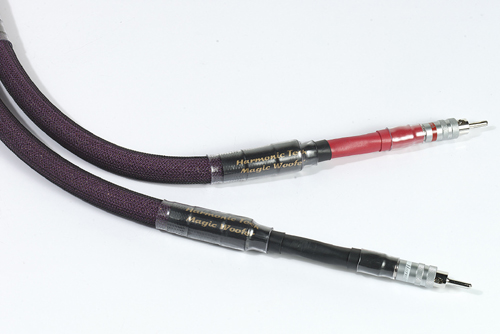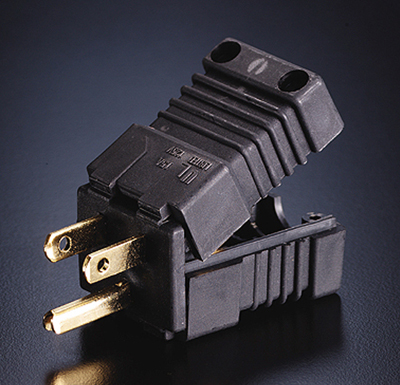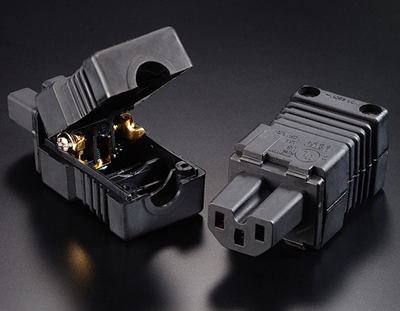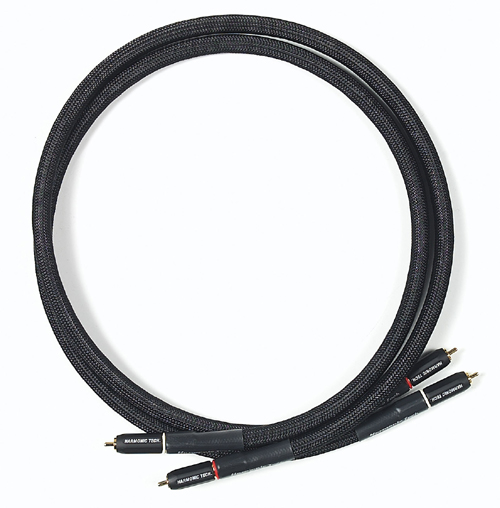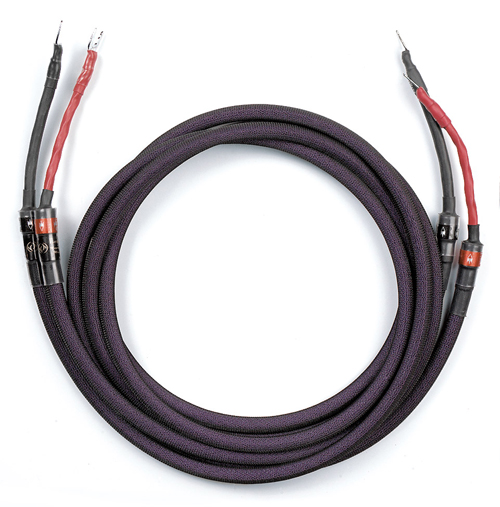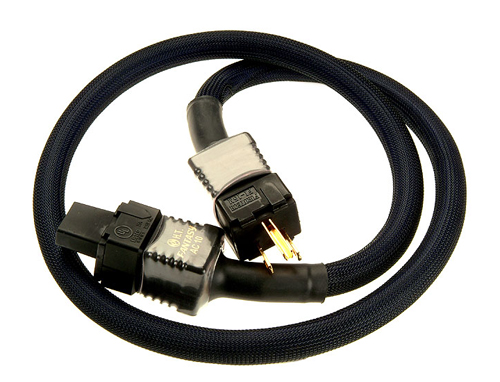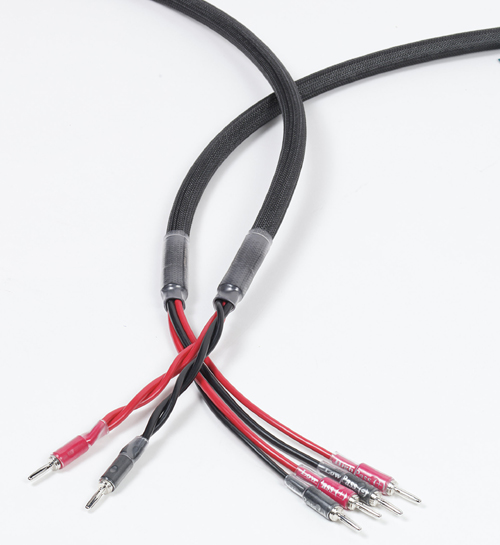|
You are reading the older HTML site Positive Feedback ISSUE 13may/june 2004
Some Harmonic Technology
Products: A Review Essay
This review also appears in this month's Audiophile Audition. Well if anyone had told me, at this late date, that my tired old ears (and I mean old) could still hear the subtle differences among a group of excellent interconnects or loudspeaker cables, even between AC wall sockets of reasonable grade and "Audiophile Grade," I'd have laughed out loud! HAH! If anyone had told me these differences would be more than just a tad discernable, like the difference between two good wines from nearby chateaux in the Margaux district, I'd have thought that person an insufferable "wine snob." Hah Hah! The joke's on me. I'm here to tell you that such differences surely exist even among barrels of the same vintage from the same chateau. Or, when a master chef runs low on an ingredient and uses a substitute in a kind of slap-dash way, thinking; "Oh what the hell. So tonight it will taste a little different; parsley instead of chervil in the sauce. No one will notice, except me." But to some truly gourmet restaurant patrons that small difference is all the difference in the world. And to my ears, depending on my state of concentration, some small audio differences are both non-existent (as when my system hasn't "warmed up" appropriately) and Renée Flemming's buttery voice takes on a slight metallic quality that will soon go away, and all the differences that count (as when output tubes are biased just right) make John Coltrane and Johnny Hartman seem to bloom right "in the room" with me. It is then that I can forgive myself my discerning posture and my obsessive fussiness that is part and parcel of being an audiophile. There is a world of difference between "not quite right" and "just right" that drives us to distraction, makes strong men spend, and takes weak men to divorce court. To take another tack, I just heard an interview with a man, Aaron Shearer, an eighty-three year old classical guitar teacher who has spent a career developing many of the world's best classical guitar players, that I'd like to note on here. Recently interviewed for a documentary on his musical career, and filmed by audio-buddy Paul Loeschke, Shearer reported having experiences that I've experienced myself. Shearer said sometimes he'd been driving in his car, letting his mind wander, listening to music on the radio, and some piece was played so beautifully he had to pull himself off the road to weep tears of aesthetic pleasure - he was so moved. I think it is particularly human to have that response to music. "Wow!! Did you hear that?" I'll bug my kids; or, "Aren't you moved by that?" I'll harangue my wife. Or, I'll phone one of my unsuspecting audio buddies at an odd hour with an, "Did you hear the latest Hilary Hahn CD? Isn't that exquisite?" Am I a nut? A nut to be so moved by mere musical beauty? My response isn't that atypical. I suspect many readers of this column experience it too. And isn't that yet another element in what being an audiophile is all about? Lots of folks are moved by music, live or recorded. So if the grand passions of a Puccini opera move you, or the cool cerebral analysis of the late Schubert string quartets grabs you, you are not alone. Human beings wrote that music. Not birds, who make beautiful music, but only their specie's various calls. Not any of the other mammals, who vocalize during the mating season. Only humans. And those of us who get the call and have the talent feel compelled to play music for our friends and neighbors, even if being a musician means mostly being ever on the brink of financial catastrophe. Living as we do in this high-technology era, where the world is more accessible to us than to any previous generation, we are beneficiaries of modern travel, medicine, communications, audio technology, and centuries of recorded music from every pie-wedge of the globe. (How can a globe have corners?) You needn't have the latest rig of multi-channel surround-sound gear. You can do nicely with headphones and a portable CD player. But, if music moves you, you can still benefit largely from a quality audio rig, and you can likely improve your sound with Harmonic Technology (HT) audiophile products. They are all very well thought out and executed examples of the latest technology. Let me begin at the beginning with this caveat: Harmonic Technology products are not necessarily THE BEST. They sound great to me, but they may not sound as good on your gear, in your room, through your ears, and processed by your brain. The mileage will vary with the driver.
The Furutech™ AC wall sockets and three prong plugs (distributed by Harmonic Technology) are designed with the latest materials in use. They feature long, flat tines of the proper electro-metallurgic properties (non-magnetic bronze or phosphor-bronze for all metal parts), to act as conductors in plugs and sockets; polycarbonate covers that have low capacitance storage values to insure minimal unwanted capacitance is added. Polycarbonate is used as the dielectric in some quality capacitors, and its audio qualities are known. In its solid, as opposed to soft, state it machines or molds nicely. The socket also features spring-loaded tines to insure maximum mechanical contact along the length of the prongs, hence minimum arcing within the housing; a glass-filled high temperature Nylon body (instead of more common plastic) to act as flame retardant; a 0.25 inch deeper overall size, compared with regular sockets, to allow the longer tines to achieve the desired contact; 24 k gold plating, or, if you'd prefer, rhodium plating on the bronze parts. And yes, I can hear the difference between gold plating and rhodium plating, though I have to focus on that and only that, listening for white noise, which is no way to listen to music. You could too, if you paid attention, and were willing to take the time. Do they make a difference? You bet! Mostly cleaner, sweeter, airier highs. Each part in the wall socket and three prong plug has been well thought out and is considered to be audiophile-appropriate. I've been interested in the metallurgy of audiophile products for a long while. I remember when patch cords (er, interconnects) were made of relatively inexpensive (perhaps $0.05 a piece) zinc-plated RCA plugs that used MDF (medium density fiberboard) as insulation, with tinned copper wire in co-axial configuration (perhaps $0.05 per foot), with clear PVC (polyvinyl-chloride) insulation inside the co-ax I soldered up myself at age twelve; and I remember when rubber insulated lamp cord (er, speaker cable) was in common use on loudspeakers. They didn't sound terrible, but that was the state-of-the-art: not terrible, but not good. I remember when Monster Cable came out with the first batch of improvements: fat, pink, oxygen-free copper (OFC), finely stranded speaker cables, with gold-plated terminators. An ear-opener. I've heard what some of the smallest things can do to the playback chain; like gold-plating onto nickel that's been plated onto brass. Modern RCA jacks and plugs frequently use this method because it is shinier, even though gold plated directly onto copper (well, a copper alloy), sounds less tizzy. This tizz, I've read, is the sound of the signal dioding between the layers of the electroplating; or, perhaps, the signal arcing between individual strands in the conductor itself; or arcing between the individual strands of the woven return; or some combination (at various frequencies) of all. Some of the headiest people in the industry keep trying to eliminate these and similar sources of noise. For example, Harmonic Technology uses a four step electroplating process on their bronze parts—Cu-Ag-Cu-Au (or Rh) as stated in their promotional literature—to minimize tizz in their RCAs and banana jacks. Of course to really get rid of tizz, all the brands, the whole industry from the recording studio on to the manufacturers of consumer gear, would have to standardize "metallurgically speaking." Not a bad idea. Are you listening RIAA? Harmonic Technology is on that. Their Furutech™ three-pin AC wall plugs and sockets are designed to eliminate, or minimize, arcing at the source of our electric power, and to eliminate or minimize the consequent hashy white noise that rides audibly on much of the two highest octaves in the audio bandwidth, 5k-10k, and 10k-20 kHz.
After Monster Cable™ introduced their concerns about metals and plating, they (and other manufacturers) began focusing on low capacitance insulation. Soon various manufacturers were vying for bragging rights on who had the lowest capacitance insulation, and polyethylene (low), followed by polypropylene (lower), and eventually Teflon (lowest) each enjoyed a vogue. All worked well and the varying physical characteristics that made them appropriate for different uses were sorted out. For example, Teflon can be fabricated hard and heat resistant, so it serves very well as insulation inside RCA jacks and plugs that must be soldered onto, or as the sub-stratum for printed circuit boards. Polyethylene™ is soft and flexible and may be used in applications where flexibility is important, such as in most light-weight tone-arm wiring, or in reducing the heavy weight of speaker cables, where it is more job-appropriate than bulky and stiff Teflon™. Polypropylene™ is "self-healing" in the sense that it can recover its up-to-spec performance after an insult, such as arcing inside the windings of a capacitor, where it can actually melt and reset as it cools. And, being low-capacitance, all these molecular substances sound a whole lot better than the time-smearing PVC, or tizzy Mylar™ we'd been hearing. Harmonic Technology is on that. They coat individual strands of copper or silver with air formed polyethylene (flexible, low storage insulation) to eliminate oxidation over time, and to eliminate low voltage arcing of the signal inside the bundles; they use Teflon™ as insulation inside their RCA plugs; and they use polypropylene, polyvinyl-chloride, and silicone in the wrap and jacketing of their various cables where appropriate. Some manufacturers, notably Nordost and Goertz Alpha Core, experimented with thin ribbons of copper and silver, so thin (it could be poetically said) they were "all surface," and thus forced a greater portion of signal transmissions to run on the skin, and only minimally in the center core of the ribbon conductors. That was one approach to "using" the skin effect. Rival engineers at competing companies discovered various means of spiraling round wire filaments within the interconnects and speaker cables creating a magnetic field that helped reject Radio Frequency Interference and Electric Magnetic Interference. Much trial and error went into discovering which cable geometry was doing the best job. The Cardas and Kimber cable companies led the way through that period of development. Harmonic Technology is on that. Together with audio-ideal metals (which reduced noise), audio-ideal low capacitance insulation (which reduced tizz and time-smearing), the more nearly audio-ideal cable geometries (which reduced broadcast and household noise) brought the manufacture of audiophile cables to a new level. Joining these design developments with the Ono Constant Casting (OCC) methods for purifying metal into "Single Crystal" wire, and utilizing wires of various diameters in their "Balanced Field Geometry," Harmonic Technology has produced a new generation of cables. To radically reduce noise of electrons colliding at the crystal interface surfaces inside the filaments themselves, the copper used in interconnects and speaker cables would have to be as pure (and some say soft) as possible, so the crystals could migrate and align during manufacture. Harmonic Technology (HT) is on that. They (HT) use Ono Constant Casting (OCC) metals in just about the whole of their line. OCC copper is (99.9997%) pure when HT uses their 6N copper, and OCC silver is (99.99997%) pure when HT uses 7N silver. The Ono Corporation enjoys protective patents about just what heat and pressure the filaments in their wires are held to when extruded that result in great purity. Harmonic Technology uses its own, similarly proprietary, process of treating the wires during manufacture to additionally make the filaments form copper crystals that "line up" into "tunnels" so the electrons can pass through the wires with a minimum number of collisions. This processing follows the lead initiated by "super conductor" research. HT exercises poetic license when they say their copper cables are, in effect, one "Single Crystal" It might be more accurate to say they have minimized the probability of random crystals blocking the "tunnels" and creating unwanted electron collisions by getting the molecules to line up in crystalline formations that (as much as possible) act as if they were one single crystal. They claim that in typical wire there are 1500 crystals per meter, while in Harmonic Technology Single Crystal wire there is, effectively, one. Harmonic Technology engineers have also studied "skin effect" and understand how to use to their advantage that electrons move faster on the surface of conductors than they do in the center core, at different propagation velocities in copper than in silver. HT engineers have similarly studied what happens in the center core of the filaments to minimize collisions. They seem to have worked out which size diameter filaments, of which metals, need to be used in what ratios to bring the arrival times of the signal at the skin and at the core to be simultaneous, or as nearly as possible. HT has worked out the geometry of the lay of the windings (when to use metal, and when to use filler, which dielectric insulation to use) in the ratios that best reduce RFI and EMI induced distortion. This results in what they term their Balanced Field Geometry™. So they are also on "skin effect" and "geometry" of the windings in their various cables, and how and when to use which metal, and which low capacitance insulation. Each aspect of cable design, and each of the possible variations, seems to have been analyzed and optimized, as far as possible, in the range of Harmonic Technology products. Not all HT cables are the same. Harmonic Technology manufactures all-silver interconnect cables designed especially for low-level LP phono purposes that have an elaborate grounding scheme to shield them from noise, that are very dynamic and wide band. They make interconnects for higher-level pre-amp connections. They make digital SP/DIF (Sony Phillips/Digital Interface) cables for DVD, or Home Theater, and they make various loudspeaker cables, from 16AWG to 9AWG. Some cables are all-copper, and others use silver and copper, and still others are all-silver. Some have very many filaments, others very few. It depends on the current requirements of the application. The audible results are very ear-opening! When I say "ear-opening," that is of course an exaggeration, making it seem as if the distance between the Harmonic Technology cables and the competition is very great. We view these phenomena as if on logarithmic graph paper, with which small differences are taken out of scale and multiplied to much larger than real proportions, just so they may be studied. So remember, in reality, the differences between Harmonic Technology products and some of their competitors, are, in real proportions, on many pretty good systems, of such a small order of magnitude that one might sometimes be fooled and mistake them for each other. After all, lots of cable manufacturers know about metals, insulation, rope-lay geometry. What sets Harmonic Technology apart is HT seems to pay a lot of attention to theory, to detail, to fit and finish, so much so that they do seem to get more out of the same meter of wire than most of the others (though there are so many nowadays that I must admit I can't keep up with all of them). Again, what I hear on my system is likely to be different to what you hear on yours. But, on a high resolution system, the smallest differences—in, for example, clarity or dynamics—can often be the biggest ones that change "not quite right" to "just right." Ironically, on entry level to mid-fi systems Harmonic Technology products might cause a relatively large improvement. The Absolute Sound, in a recent pair of issues (146 & 147), conducted a survey of some dozen of different manufacturers speaker cables in which the Harmonic Technology figured prominently. The two reviewers agreed that the HT Pro-11 Plus was among the upper tier of their dozen in the under $500 category. And, as they said, there was no clear winner. There were clusters closer and closer to the bull's eye. The $475 Pro-11 Plus was among those nearest to the ideal. So, with all the caveats, and reservations about how small differences are, the HT speaker cables figured to be pretty good. I think all the technology mentioned above; metallurgy (using audio-optimum metals), product engineering (using maximum contact audio-optimum AC plugs and sockets, locking RCA plugs, locking banana jacks), materials research (for audio-optimum low capacitance insulation), physical chemistry (methods developed to utilize the skin effect as complementary to the center core conductor effects for audio-optimum results), the lay of the rope-like cables for best RFI and EMI rejection, all these layers of engineering that go into Harmonic Technology products make for increasingly small losses and add up to a result that is a very "musically rewarding... tonally neutral" cable, one with "gusto and complexity." I agree with Neil Gader and Paul Seydor, my pals over at TAS, in their subjective impressions of how the cables sound. I'd add, HT cables usually yield a wide and deep sound-stage, extended highs with minimal tizz, and deep yet punchy bass. To begin at the end: the last thing I did was install a Furutech™ (distributed by Harmonic Technology) "Audiophile Grade," AC wall socket. It was last because I wanted to insure that I had done all I could to clean up my system with HT interconnects and speaker cables. When I was certain that things were optimized and as clean as I could get them, then and only then would I install the AC wall socket not to mention that it is a significant project for which one has to find the right breaker after disassembling the breaker box, switch off the current to avoid being fried, and then wrestle with a shielded cable to get enough slack to work with while exchanging the new socket for the old plastic Leviton™. When I'd reassembled my in-wall connection, and breaker box, the better part of 45 minutes had elapsed and I began to notice a bottle of Johnny Walker Blue Label™ beckoning. But who's complaining? Nobody likes a complainer. Besides, it was worth it. At first I could hear no difference!! And after all that work. Slowly (either as my ears adjusted, or as the little molecules lined up in the metal parts of the socket, and the insulation "formed" as in a capacitor), things became clearer. After about twenty minutes, the highs were cleaner, airier, and more extended. This was a subtlety first noticed when, on solo violin recordings, the residual bowing noises that I'd grown used to, diminished noticeably!! Then I started listening to other things: certain flute passages that I'd found a bit too spikey... smoothed out; cymbals that I thought shimmered a tad overmuch... cleaned up; and harpsichords I'd found a smidgeon too tinny... calmed down. I theorized there had been a slight residue of white noise riding on the AC that found its way past my "current conditioner" into the signal path, and (in the past) when it was in some multiple of the music being played, this noise went into sympathetic resonance with the signal and added tizz (what would look like fuzz on an oscilloscope) to the pure tones (what would look like the pure sine waves) of the violins, flutes, cymbals, and harpsichords. This is another of my metaphors. I know that recordings of single instruments represented on an oscilloscope have various spuriae that look like fuzz, and which represent their timbre. If each instrument didn't have its package of overtones they'd all sound like test tones, perfect sine waves, and wouldn't that be exciting? I sometimes distort things for rhetorical purposes. I hope you'll allow me to do this, as I am not an engineer. I might say the difference between the two sockets was "as if comparing clean and compromised sine waves on an oscilloscope," but that sounds clunky. Who was it that said, "I strive for brevity, but I become obscure." It was another case of addition by subtraction of spuriae. With the Furutech™ socket in the wall, high frequencies sounded as if smoothed out, cleaned up, and calmed down. I was flummoxed. (I really like that word.) In truth, I expected something based on theoretical models to happen. One of my audio buddies, Alan Shapiro (who had Lowthers on a Pooged Dyna Stereo 70 running in triode thirty years ago), said he thought the Furutech™ socket had "tipped up" the highs. I think by eliminating the tizz, the highs seemed louder or "tipped up," as would be represented in a frequency-response curve. Cleaner seems louder? The Furutech™ AC wall socket ($78 gold plated, $130 rhodium plated) has to be one of the most cost effective means of cleaning up the high frequencies of any audio system. Before I'd gotten to that step, I'd had something of an Homeric Odyssey through the Harmonic Technology line. Jim Wang, at HT, had taken me as a student to mentor. First he sent me some of his products that seemed designed for Rock music, Truth-Link Silver interconnects, and Fantasy speaker cables. I had been using some other "well-respected" speaker cables: the Goertz Silver AG 2 Veracity ribbon speaker cables that I liked a lot. I was surprised by the relative increase in dynamics the HT Fantasy speaker cable brought to the music when I substituted it for the Goertz. Cleaner seems louder? I had also been using the Goertz Copper ribbon speaker cable of the same configuration on my Isobarik woofers. When I swapped in the HT Fantasy for the Goertz Copper the bass got bigger and tighter. There seemed to be no discontinuity between the bass (100Hz and down, which was revealed as having been a little lumpy), and the rest of my speaker system (100Hz and up). On acoustic jazz bass solos, when the playing caused the instrument to go both above and below my cross-over point, there had been a woolly, slightly-out-of-control quality to the notes below 100Hz with the Goertz copper ribbon loudspeaker cable. That quality went away with the substitution of the HT Fantasy, and the speaker achieved what I understand to be "continuousness." It also seemed punchier. Cleaner seems louder?
Truth-Link interconnects There was no such striking change between the Goertz Silver TQ2 (Triode Quartz 2) and the HT Truth-Link Silver, the swap I made for my 100Hz-and-up amps' interconnects. Between these two, the mid-range was about the same, but the Truth-Links seemed a noticeable tad or two brighter in the 3kHz to 9kHz range. (Now remember, this is a subjective report, albeit an educated one.) Cymbals JUMPED out of the speakers. Rock and jazz had an UP FRONT immediacy that such music demands. On classical music, alas, there was just too much high frequency emphasis coming off the violins. Being foremost a classical music lover I sought a less frontal interconnect. I spoke to Jim Wang again, and he volunteered to send me some unspecified stuff to remedy the situation. A short time later I had some of his Truth Link-Copper interconnects and a pair of Magic Tweeter Speaker Cable. Boy, oh boy. I didn't expect the top of their line, but there it was. A beauty. And great sounding. This setup was more delicately balanced and made the solo violin sound much like a solo violin sounds in my local symphony hall (as best as I can remember, and I sit up close), with much less evident bowing and scraping. The woofers' loudspeaker cables, HT Fantasy, with which I was pleased stayed the same. The "tweeter" cables, HT's Magic "Tweeter" Speaker Cable, did bring at least a couple of units of magic to my rig. Not only were they cooler on violins, but everything seemed a tad more spacious, less artificially brilliant, more open, more natural, more truthful. When Johnny Hartman and John Coltrane began to sing and play "You are Too Beautiful" it was as if they were in the room with me, and I got goose-bumps.
Magic Tweeter Speaker Cables Once, setting up for my wife, La Dudeen, she asked me if I were singing. Imagine being mistaken for John Pizzarelli, whose voice sounds somewhat like mine in timbre and register! I was flattered. But the flattery was deserved by the cables. If she thought anyone might have been singing live, and in the room (accompanying the performers) when it was the stereo rig, well I really felt as if the electro-mechanical limitations of the playback chain had been somewhat transcended—that's how good the illusion had become! When I was tired and grumpy from moving all my heavy gear around and working up a sweat (at my age), just to get the damn system wired up right, in phase, and all that, just for you, dear reader (I'm not complaining!), I weakened and took a snort from that bottle of Johnny Walker's Blue Label, the remnants of which a friend had brought me to taste. (Not bad. A bit like Lagavulin at thrice the price. Maybe I took two or three snorts.) Then I played an album of DeeDee Bridgewater, Live at Soshi's, and heard her jiving with a patron sitting ringside while singing "Love For Sale." Hearing the crowd's reactive laughing, glasses clinking, chairs shuffling, I felt like maybe I could hear down the recording chain to the original event! I found a less than terrific sounding version of George Szell and the Cleveland Symphony Orchestra in its prime (1968) playing the Mahler Symphony #9, and the cables improved on the playback I was used to, so much so I felt I could hear back through the mist to the only time I heard Szell play that work, in the ‘60s, at D.C.'s Constitution Hall, with Corno di Bassetto and his wife, the dulcet-toned Elena di Bassetto. It was as if Harmonic Technology's Magic loudspeaker cables could put me in Bill and Ted's Most Excellent Time Machine, and grant me an epiphany updated from Proust's taste of a madelaine that transported him from his adult self to his grandmother's garden where as a child he had first tasted one. I remembered it vividly, how the tuxedoed Szell, now grown old, crouched on the podium like an aging panther about to lunge, and led the orchestra down from a crescendo, diminuendo-ing through the stages of fff, ff, f, p, pp, ppp quieter,... quieter,.... to absolute... ... .... silence. A few days later, another audio pal and Mahlerite, Hilary Gans, came by to listen. He knew I loved Mahler, too, so he brought yet another copy of Mahler's Symphony #9, Sir Georg Solti and the Chicago Symphony Orchestra (early ‘80s) for us to hear. I popped it in the tray and I let it rip at pretty good facsimile volume. After we'd listened to the final movement, we looked at each other and realized we were snuffling into our handkerchiefs. I didn't get into, "Whaddaya think of the bass, Hills?" He just blurted out, "God's sake, Max. That's magnificent. I'm torn up." I told him about the time I saw Maestro David Zinman conduct the work, and it took him two or three minutes to pull himself together before he could finally face the audience at the end, the Maestro was so torn up. I didn't tell him about the (perhaps apocryphal) time Leonard Bernstein was rehearsing for one of his recordings of the work, and tore up half the orchestra so badly they all had to take a ten minute break. It might have made him feel better, but I thought he'd have felt I was laying it on. But I'm telling you. I think one of the hidden agendas of this audio hobby is often unspoken. Each of us probably remembers what music was playing when we had an especially moving moment with our high school sweetie, or our first genuine adult sexual thrill, as we remember where we were and what we were doing when President Kennedy was shot, or when we landed on the moon. It doesn't matter if it was Prokofiev's Romeo and Juliet, or The Five Satins' "In The Still Of The Night," or Frank Sinatra's "I Get A Kick Out Of You." Whatever the music was, it catapults us back in time and we remember the sights, the smells, the feelings we were experiencing at the time. Music has the power to do this to us. Playing certain music can take us out of ourselves for a while. Sometimes that can move us to tears. That's not the only thing music can do, but it seems to be a major element. Music is a powerful mood enhancer, and it's legal. If we're lucky, and flexible, we can generalize from our emotional favorites to accepting other music unrelated to any particular event.
Fantasy AC-10 AC cables If that's where you want to go, whether to a jazz club, a symphony hall, or back down the time tunnel, Harmonic Technology can take you there with a high-resolution system. I'm not guaranteeing anything, but they've worked wonders for my elaborate system and for my daughter's more basic system in a makeshift "experiment." In my system, the wall sockets, the three-pronged plugs, the Fantasy AC 10 power cords to my amps and CD player, each added a tad of cleanliness by subtracting yet another smidgeon of fuzz or hash, dry-cleaned the music with such grace and elegance that they eliminated the toxic spuriae; the phono cables, interconnects, speaker cables, each revealed yet another iota of truth, by contributing atoms of magic, molecules of verisimilitude, until the facsimile of the real event occurring in my listening room became nearly palpable, as if you could reach out and touch someone, or ping the cymbal with your thumbnail. If that's where you want to go, you can with HT cables, the right gear, the right room, and your head in the right place. This is especially true for solo instruments, like the Bach Suites For Solo Cello, say, or small ensembles, as in the Bartok Contrasts (for piano, violin, and clarinet), or Olivier's Messaien's Quartet For The End Of Time (for piano, violin, cello, and clarinet), or Stravinsky's The Soldier's Tale for seven instruments. Of course, the Dave Brubeck Quartet, The Modern Jazz Quartet, and various Miles Davis Quintets sound damn vivid, and I can catch everything. With larger ensembles, I can catch nearly everything, and I was astonished at the fine details that made their way out of the great wall of sound. On the recording of Vladimir Ashkenazy conducting The Concertgebouw Orchestra of Amsterdam, playing Rachmaninoff's Symphonic Dances, where (with the orchestra in full cry) I could better-than-ever isolate the single and specific activities of the triangle, tambourine, and cymbals (that are all nearly in the same register) during the opening section. Cleaner cleans, m'lads. And louder louds, I do believe. Other reviewers have commented that music played through Harmonic Technology products seems louder, at first causing them to go to the volume control only to notice it was at the same setting as it was with the last pair of cables. I don't know how to verify this with an acceptable test without hiring time in an anechoic chamber, which I can't afford for each review. But, I too experienced that surprise. I can only surmise that other cables are more lossy, or have a higher impedance measured in Ohms. Each reviewer seems to agree the Harmonic Technology products improve his system's dynamics. Cleaner seems louder? Remember, it takes double the amplifier power to increase output 3 dBs. If you can pick up some portion of that by cleaner cables, it is as though you've added significant power to your amplifier. Or, to put it another way, some cables can diminish the output of your amp: too light AWG gauge cables act as a resistor and dissipate your amps power by throwing it off as heat. If you are a novice, or are operating on a tight budget (no dishonor), try one pair of interconnects. If you like Rock or Jazz, try HT Truth-Link (Silver) at $300: for Classics, try Truth-Link (Copper) at $250. If you are convinced of the value in the product line, you might begin the Odyssey through the menu list with a Furutech™ FP-2G AC socket (at $78, a great investment for cleaning up your receiver), and a pair of HT Fantasy loudspeaker cables (excellent performance at $350), to go with your pair of Truth-Link interconnects. What I heard with this trio in my system was a delightful combination of qualities. I heard cleaner highs than I'd heard with pretty well-respected interconnects. They were high and airy, seemingly louder with respect to the mid-ranges; had more space around the instruments that yielded the illusion of a wider and deeper sound-stage; and had greater punch yet tightness to the bass, reducing bloat, commonly called "boom." These three elements, AC wall socket, interconnects for the CD player, and speaker cable, ought to elevate a respectable mid-fi system, or a college kid's system, up in class a notch or two.
Fantasy Speaker Cables If you're farther along in the development of your system, the same holds true, but the price goes up. If you own high power amplifiers, to experience what you paid for, you ought to have good quality AC cords to power your amp, and real good loudspeaker cables. If you're one of those guys who has set up a trust fund for just his audio system, cool. We welcome your deeper pockets. If you're more like the rest of us, guys getting by on a nice salary, think of what comes next as a cautionary tale. To deliver the power from the wall (or your Voltage Regulator, or your Current Conditioner) to your gear, you'll need AC cords that follow all the usual design requirements of a good power cord - heavy gauge, proper insulation, correct geometry, quality terminators, etc. Any of the HT Power Cords will do, but the PRO-AC11 CL-3 may be the most cost effective ($240). To deliver the high current music signal to your speakers, the same rules apply. In theory, the heavier the current load, the heavier the speaker cables. And, again, any of the Speaker Cables will do sonically, and matching your amp's output with the gauge of the cables is a good rule of thumb: more Watts needs Heavier Gauge, and each increase in gauge is represented by a lower AWG number. So AWG 9 is twice as thick as AWG 10, which is in turn four times as thick as AWG 11, and eight times as thick as AWG 12 (though only three steps lower in the classification system). "How does this work out in practice?" you might ask. The answer is harder because there are more, and more differing, requirements. Each rig is different. Are you running tubes or transistors? Are your speakers inefficient (electrostatics) or efficient (horn loaded drivers)? And all the stops in between. The Harmonic Technology products have a family likeness, like freckles, with nearly all of their products having a similar sonic thumbprint as I've described. The prices go up as the need for greater power goes up, and the amount of metal actually increases. You can't run a refrigerator/freezer with lamp cord. You'd be tripping the breakers every ten minutes. This gets expensive as the proportion of silver increases. But in a system like mine, driving a medium efficiency speaker rig with a pair of high powered Parasound JC-1 amplifiers running Class A most of the time, I need good power-handling AC cords and speaker cables. Sometimes, my Monster Power Regulator's meter tells me, I draw ten or more amps for a loud passage of music. You also need a good audio dealer with experience in such matters. You dealers out there, you ought to read up on the requirements of different speakers and amps to make outstanding sound result when your client invests cash and trust in your relationship. Maybe I'll qualify that to read, "to make outstanding sound at whatever the price point result." You owe your customers as much. I won't presume to lecture you any further than that. But we know who you are. I'd like to remind you that I don't like to write negative reviews. I select my assignments on the basis that I am already enthusiastic about the products I review. So if it seems I have nothing nasty to say about a product, it's because in order to seem Mr. Nice Guy, I screen products before hand. I am enthusiastic about the Harmonic Technology line because it is a group of products that allow my hardware to sound its best. As a reviewer, this is important to me because I want every manufacturer's product to sound its best in my rig. I consider it my duty to get them to sound as good as the designer heard them. It is oh so easy to make products sound bad. If I have a CD player to evaluate, I want to know if its tone is flat, how it sounds when the music gets loud or soft. In an orchestral piece, for example, does the trumpet get convincingly loud and soft as the music demands? And does the trumpet player seem to leap from the rear of the orchestra to the front and back again as he plays loudly and softly? Or does he stay in his place? And does the orchestra seem to spread out in space when playing softly? And cramp together in the center when playing loudly? Think of the cartoonist's opportunities. Many interconnect and speaker cables don't sort these differentiations well. Since these questions might tell me a lot about how the analog section of the CD player is doing, I want to know in accurate detail for my review. The power supply, for example, might be poorly regulated; or an oversized output capacitor might be causing a problem. The relatively inexpensive Harmonic Technology Truth-Link (Copper) interconnects ($249), together with the Fantasy speaker cable ($350), tell me the truth about such things. The top of the line HT loudspeaker cables, their Magic Reference "Tweeter" Speaker Cable ($1450) together with their Magic Reference "Woofer" Speaker Cable ($2000), probably due to their heavier gauge, allow me to hear the same things at high power levels in great detail, as if under a microscope, where lesser cables saturate and distort, or seem to cause clipping. As the loudness increases human voices do not become metallic, nor various instruments change timbre. The spatial configuration remains constant; the performers seem merely closer. The HT cables make my system more stable. At lower power levels, the HT "Tweeter" cable displays great refinement and delicacy, yet it retains its shimmer and punch. Sometimes, at higher power levels (up to 800 watts!) the HT "Tweeter" cables leave me breathless!!! At lower power they are merely magical!! At higher levels, the HT "Woofer" cable is subtle: it doesn't get louder than the Fantasy, it gets more relaxed; it doesn't boom on bass viol jazz solos, it gets tighter, more controlled, and more revealing of textures; it doesn't bring the organ in Rutter's Requiem much closer; it seems as if the pedal notes just pour into the room effortlessly, coupling to all the air on the first floor, creating large standing waves that gain in strength ‘til they arrive in the kitchen, forty-five feet away, rattling dishes in the cupboards with bass drum thwacks. Both sets of cables seem to get out of the way and allow the amps and the speakers to communicate as they were hard wired together. Driving my twin sets of isobarik 12" woofers, at higher power levels (up to 800 watts!) the HT "woofer" cables are outstanding!!! At lower power they are merely excellent!! It is for these reasons that I can most highly recommend the Harmonic Technology family of products from the least to the most expensive, depending on your needs and your budget. They deliver the Truth. Jim Wang and his gang in San Diego are big on the idea of audio truth. Some of his interconnects are called Truth-Link. In his promotional literature there is a great emphasis on truth in its various synonyms, "natural," "life-like," "as close to perfection as possible," with regard to transferring signal in an audio system. More than any family of products I know of, Harmonic Technology's products live up to their slogans. I've had more than a few, but I've never had better cables in my system. For more information on products and pricing, see their website: http://www.harmonictech.com. If you're in the market for new cables, arrange with a dealer for a free home trial. Try ‘em. You won't be sorry. You'll be happy if you keep ‘em, and even if you don't. Or, invite your local boutique owner to come over with some HT products, at various price points, to audition in your system. And if you decide to buy a new set of cables (or two), your significant other will be pleased you didn't go for a whole new Daddy Big Bucks system, the whole enchilada. What have you got to lose? Ciao Bambini.
|

